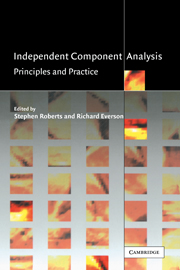Book contents
- Frontmatter
- Contents
- Preface
- Contributors
- 1 Introduction
- 2 Fast ICA by a fixed-point algorithm that maximizes non-Gaussianity
- 3 ICA, graphical models and variational methods
- 4 Nonlinear ICA
- 5 Separation of non-stationary natural signals
- 6 Separation of non-stationary sources: algorithms and performance
- 7 Blind source separation by sparse decomposition in a signal dictionary
- 8 Ensemble Learning for blind source separation
- 9 Image processing methods using ICA mixture models
- 10 Latent class and trait models for data classification and visualisation
- 11 Particle filters for non-stationary ICA
- 12 ICA: model order selection and dynamic source models
- References
- Index
5 - Separation of non-stationary natural signals
Published online by Cambridge University Press: 05 July 2014
- Frontmatter
- Contents
- Preface
- Contributors
- 1 Introduction
- 2 Fast ICA by a fixed-point algorithm that maximizes non-Gaussianity
- 3 ICA, graphical models and variational methods
- 4 Nonlinear ICA
- 5 Separation of non-stationary natural signals
- 6 Separation of non-stationary sources: algorithms and performance
- 7 Blind source separation by sparse decomposition in a signal dictionary
- 8 Ensemble Learning for blind source separation
- 9 Image processing methods using ICA mixture models
- 10 Latent class and trait models for data classification and visualisation
- 11 Particle filters for non-stationary ICA
- 12 ICA: model order selection and dynamic source models
- References
- Index
Summary
Most approaches to the problem of source separation use the assumption of statistical independence. To capture statistical independence higher order statistics are required. In this chapter we will demonstrate how higher order criteria, such as maximum kurtosis, arise naturally from the property of non-stationarity. We will also show that source separation of non-stationary signals can be based entirely on second order statistics of the signals. Natural signals, be they images or time sequences, are for the most part non-stationary. For natural signals therefore we argue that non-stationarity is the fundamental property, from which specific second or higher order separation criteria can be derived. We contrast the linear bases obtained using second order non-stationarity and ICA for the cases of natural images and speech powers. Based on these results we argue that speech powers can in fact be understood as a linear superposition of non-stationary spectro-temporal independent components, while this is not so evident for a spatial basis of images intensities. Finally we demonstrate the practical utility of the second order non-stationarity concept with a separation algorithm for the problem of convolutive source separation. We show its effectiveness on acoustic mixtures in real reverberant environments.
Second and higher order separation criteria in the context of non-stationary signals
Most approaches to source separation have been based on the condition of statistical independence of the constituent signals. Conventionally, higher order statistics are required to capture statistical independence. In fact if the source signals are identically and independently distributed (i.i.d.) samples of a stationary distribution second order statistics are not sufficient for Separation. Fortunately, natural signals are often not stationary, or independently distributed.
- Type
- Chapter
- Information
- Independent Component AnalysisPrinciples and Practice, pp. 135 - 157Publisher: Cambridge University PressPrint publication year: 2001
- 12
- Cited by



